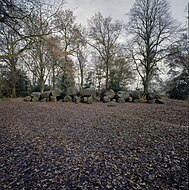Great stone grave Borger
| Great stone grave Borger Hunebed D27 | ||
|---|---|---|
|
The large stone grave D27 in Borger |
||
|
|
||
| Coordinates | 52 ° 55 '48.7 " N , 6 ° 47' 52.9" E | |
| place | Borger-Odoorn , OT Borger , Drenthe , Netherlands | |
| Emergence | 3470 to 2760 BC Chr. | |
| van Giffen no. | D27 | |
The large stone grave Borger is a megalithic tomb of the Neolithic western group of the funnel cup culture in Borger , a district of Borger-Odoorn in the Dutch province of Drenthe . With a length of 22.6 m it has the largest burial chamber of all large stone graves in the Netherlands. It bears the van Giffen number D27.
location
The grave is on the northeastern outskirts of Borger between the Hunebedstraat and the Hunebedcentrum . There are numerous other large stone graves in the vicinity: 1 km southeast are the two large stone graves at Buinen (D28 and D29), 1.6 km north the five large stone graves at Bronneger (D21 – D25), 2.1 km northwest the large stone grave Drouwenerveld (D26) and 2.6 km north-northwest the two large stone graves at Drouwen (D19 and D20).
Research history
The grave was already examined by Titia Brongersma in 1685 , who published a short report in poetry the following year . Ludolph Smids published a more detailed description of their work in 1694. Brongersma's investigation was the first documented excavation of a large stone grave in the Netherlands. In 1878 the grave was documented by William Collings Lukis and Henry Dryden . In 1918 Albert Egges van Giffen documented the facility for his atlas of the Dutch megalithic graves. In 1938 van Giffen tried to find the stand holes in the surrounding stones. According to a report by R. Westerhoff, the stones had all been removed in 1835, but their marks were still clearly visible. However, when van Giffen examined them, they were already completely eroded. A new investigation using georadar in 2010 also remained inconclusive. The grave was restored in 1937 and 1992. Since 1992 the complex has been a national monument ( Rijksmonument ).
description
The complex is an east-southeast-west-northwest oriented passage grave . Today no traces of the original stone enclosure have survived. The burial chamber has a length of 22.6 m and a width of about 4.1 m. It consists of 26 wall stones on the long sides, one end stone each on the narrow sides and nine cap stones. The access to the chamber is in the middle of the southern long side. In front of this is a corridor made of two pairs of wall stones and a capstone.
Finds
During their investigation, Lukis and Dryden found some fragments of the funnel beaker culture that are now in the British Museum in London . The pottery dates to grades 2–5 and 7 of the typological system of the Western Beaker Group established by Anna Brindley . This roughly corresponds to the period 3470–2760 BC. Chr.
literature
- Jan Albert Bakker : The opgraving in het Grote Hunebed te Borger door Titia Brongersma on June 11, 1685. In: Nieuwe Drentse Volksalmanak. Volume 101, 1984, pp. 103-116.
- Jan Albert Bakker: The Dutch Hunebedden. Megalithic Tombs of the Funnel Beaker Culture . International Monographs in Prehistory, Ann Arbor 1992, ISBN 1-87962-102-9 .
- Jan Albert Bakker: Megalithic Research in the Netherlands, 1547-1911. From 'Giant's Beds' and 'Pillars of Hercules' to accurate investigations. Sidestone Press, Leiden 2010, ISBN 9789088900341 , pp. 213-214 ( online version ).
- Albert Egges van Giffen : De Hunebedden in Nederland , 3 volumes. Oosthoek, Utrecht 1925.
- Evert van Ginkel , Sake Jager, Wijnand van der Sanden: Hunebedden. Monuments van een steentijdcultuur. Uniepers, Abcoude 1999, ISBN 978-9068252026 , p. 178.
- G. de Leeuw: Onze hunebedden. Gids before Drentse hunebedden en de Trechterbekerkultuur . Flint 'Nhoes, Borger 1984.
- William Collings Lukis : Report on the hunebedden of Drenthe, Netherlands. In: Proceedings of the Society of Antiquaries of London. 2nd series. Volume 8, 1878, pp. 47-55 ( online ).
- Wijnand van der Sanden : Een hunebed in een park - Een bijdrage tot de biography van het grote hunebed van Borger. In: Waardeel. Volume 31 (1), 2011, pp. 1-5 ( online ).
- Wijnand van der Sanden, Hans Dekker: Gids voor de hunebedden in Drenthe en Groningen . WBooks, Zwolle 2012, ISBN 978-9040007040 .
- Nynke de Vries: Excavating the Elite? Social stratification based on cremated remains in the Dutch hunebedden. Master thesis, Groningen 2015 ( online ).
Web links
- The Megalithic Portal: D27 Borger
- hunebedden.nl: Hunebed D27 te Borger
- hunebeddeninfo.nl: D27 / Borger
- JohnKuipers.ca: D27 Borger
- cruptorix.nl: D27
Individual evidence
- ^ Rijksdienst voor het Cultureel Erfgoed: 421090 te Borger
- ^ Anna L. Brindley: The typochronology of TRB West Group pottery. In: Palaeohistoria. Volume 28, 1986, pp. 93-132 ( online ).
- ^ Annual figures corrected according to Moritz Mennenga : Between Elbe and Ems. The settlements of the funnel beaker culture in northwest Germany (= early monumentality and social differentiation. Volume 13). Habelt, Bonn 2017, ISBN 978-3-7749-4118-2 , p. 93 ( online ).

